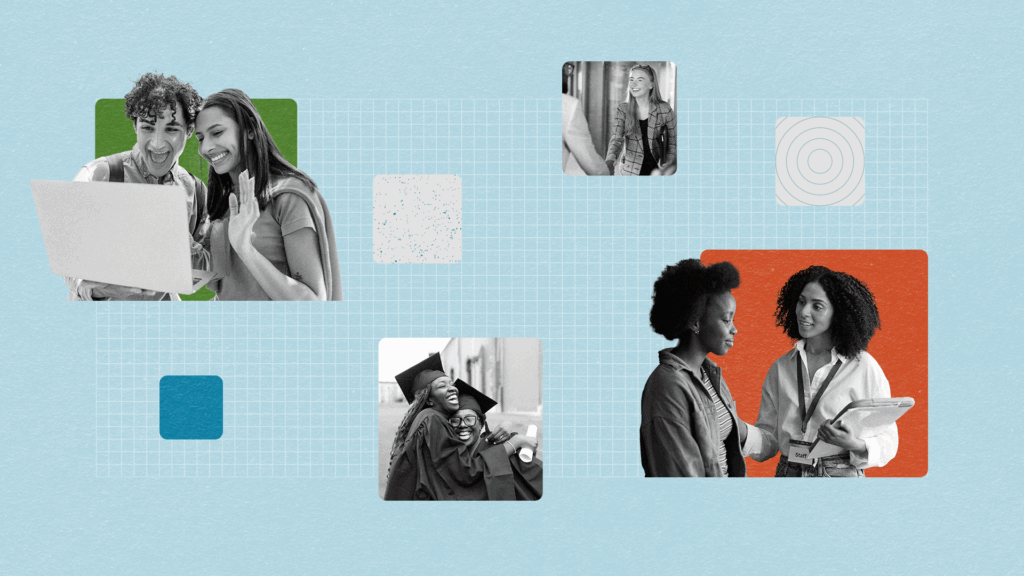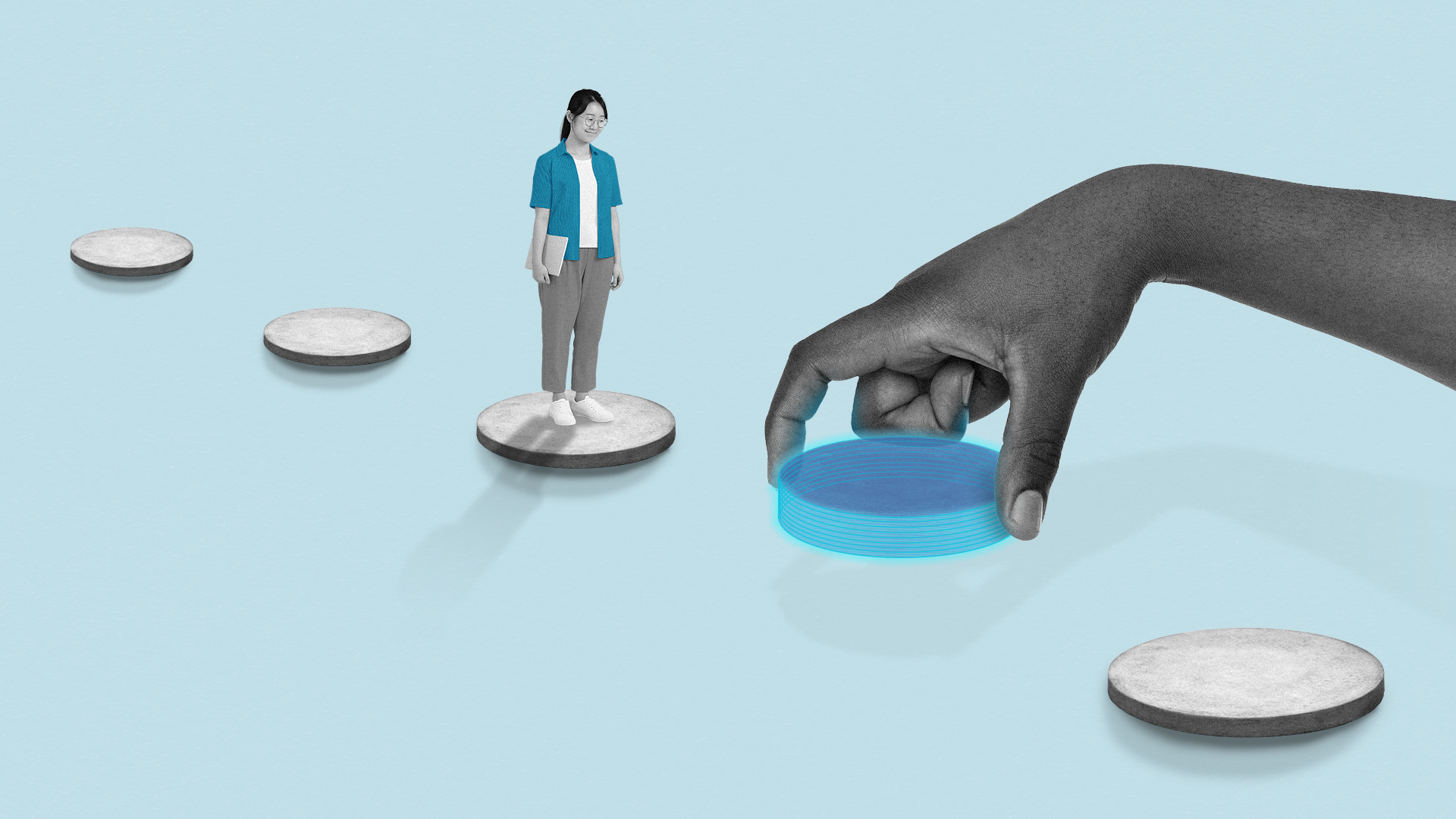When higher ed leaders talk about artificial intelligence, the conversation often centers on efficiency: grading faster, automating routine tasks, or streamlining administrative workflows. If that’s all universities can expect from AI, they’re missing its most transformative potential: helping institutions create richer human connections, stronger learning communities, and a deeper sense of belonging.
AI is more than just a productivity tool. When designed thoughtfully, AI can be infrastructure for care—proactively fostering relationships between learners, faculty, administrators, alumni, and even global peers.
How to Use AI in Higher Education
- Proactively match learners, faculty, and alumni
- Leverage AI for global and cross-cultural cohorts
- Provide safe, realistic practice for challenging conversations
- Shift from reactive to proactive student support
- Build belonging into the infrastructure
1. Proactively Match Learners, Faculty, and Alumni
In many online and hybrid learning environments, learners complete their coursework in a vacuum. Without intentional opportunities to build relationships, learners can feel disconnected from peers, faculty, and the institution itself. This lack of connection isn’t just a social problem, it directly affects engagement, persistence, and overall satisfaction with the program. AI tools overcome this obstacle by helping universities build intentional connections between learners and faculty:
AI-Driven Peer Matching
Use intelligent algorithms to connect learners with peers who share similar academic goals, professional aspirations, or life experiences. For example, an MBA student working in healthcare administration could be paired with another student in the same sector to collaborate on projects or exchange insights, without either having to search through class rosters or forums.
AI-Supported Alumni Networks
Develop opt-in alumni communities where AI recommends mentors based on shared degree programs, career paths, and geographic proximity. A recent graduate seeking guidance in nonprofit management, for instance, could be automatically introduced to an alum working in that exact field.
“Stretch” Connections for Broader Perspectives
Go beyond comfort zones by using AI to introduce learners to peers with different cultural backgrounds, industries, or areas of study. A U.S.-based engineering student could be connected with a peer in India studying renewable energy, enriching both perspectives.
AI IN ACTION
Salesforce’s Career Connect uses AI to map employee skills and career goals to open roles inside the company. By surfacing transferable strengths and suggesting tailored opportunities, the platform helps staff pivot into new positions. In its pilot, over 90% of roles filled were matched through Career Connect.
When higher ed institutions harness AI to create purposeful, personalized connections, community-building becomes a built-in feature of the learning experience. Over time, these networks can strengthen loyalty, increase persistence, and help graduates remain engaged with the institution long after earning their degree.
2. Leverage AI for Global and Cross-Cultural Cohorts
Higher education has long recognized the value of diverse perspectives. And yet, outside of dedicated study-abroad programs or intentionally global cohorts, many learners miss out on meaningful cross-cultural collaboration. In online and hybrid formats, this gap can be even more pronounced. Without intentional design, institutions risk losing the powerful benefits of exposing learners to different cultural, professional, and geographic viewpoints, which are increasingly critical in a globalized workforce. AI can help unblock these global connections with:
Intelligent Geographic and Professional Pairing
Use AI to identify learners studying similar disciplines across campuses or countries and suggest direct connections. For example, an undergraduate in business analytics in the U.S. could be paired with a student in Singapore working on data ethics, opening opportunities for cross-border collaboration.
AI-Facilitated Peer Exchange Projects
Implement structured case studies or group assignments where AI organizes culturally diverse teams based on complementary skills and goals. The technology can also recommend global discussion prompts that highlight different regulatory, cultural, or economic contexts.
Real-Time Translation and Contextual Tools
Integrate AI translation with cultural nuance features so learners can communicate more effectively. A discussion between a nursing student in Brazil and a peer in Germany could automatically include contextual healthcare policy references, enhancing comprehension and relevance.
AI IN ACTION
Meta’s new AI-powered tool automatically dubs Reels between English and Spanish with synchronized lip movements and natural voice tone, enabling creators to reach global audiences more authentically. The feature auto‑detects users’ language preferences, labeling and surfacing AI‑translated content for seamless cross‑language engagement.
By leveraging AI to surface and support global connections, institutions can turn a geographically dispersed student body into a competitive advantage. Learners develop cultural agility, broaden their professional networks, and gain firsthand insights into how global contexts shape problem-solving. For universities, this creates graduates who are academically prepared and globally fluent, strengthening institutional reputation and appeal in a competitive market.
3. Provide Safe, Realistic Practice for Challenging Conversations
Learners and faculty regularly face high-stakes conversations that require confidence, empathy, and clarity. Yet most programs teach what to say, not how to say it. Without practice, learners can feel unprepared and faculty may struggle in challenging situations—undermining trust and escalating conflicts. AI can close this gap by offering safe, realistic simulations that help participants build skills and confidence before entering professional settings.
AI-Driven Role-Play with Real-Time Feedback
AI tools (like Noodle’s ScenarioAI) can simulate interactions with “agents” that respond dynamically to tone, body language, and word choice. For example, a teacher-in-training could practice a parent-teacher conference where the parent is upset, receiving immediate coaching on phrasing and tone.
Customized Scenarios for Different Roles
Design role-specific simulations—nursing students navigating patient conversations, MBA students negotiating contracts, or faculty practicing mentoring discussions with TAs—such that AI adapts the difficulty and complexity based on the user’s skill level.
Challenging Viewpoint Exposure
Allow learners to safely engage in respectful discourse with AI agents holding opposing perspectives on ethical or policy issues. This helps develop critical thinking, active listening, and emotional regulation in heated discussions.
AI IN ACTION
Unilever uses BetterUp Grow to deliver personalized, real-time guidance that adapts to each employee’s role, style, and goals. The platform helps staff practice tough conversations and stay on track, while providing HR leaders with talent intelligence dashboards that highlight workforce challenges.
AI-powered practice environments transform communication skills from theory into action. Institutions that integrate AI simulations into curricula graduate more career-ready learners while fostering healthier, more respectful academic communities. Over time, this capability becomes a differentiator that signals to prospective learners and employers that graduates are equipped to navigate the human side of professional success.
4. Shift from Reactive to Proactive Student Support
Many higher education institutions rely on reactive support systems to address academic or engagement issues. But only after they’ve already become serious. By this point, learners may already feel disconnected, overwhelmed, or ready to withdraw. This jeopardizes retention and places unnecessary strain on student services teams, who are left to address preventable problems in crisis mode. AI flips this on its head, offering predictive and personalized interventions before a crisis occurs:
Early Engagement Flagging
AI can monitor participation patterns in real time, identifying when a student’s logins, discussion activity, or assignment submissions fall below typical benchmarks. Advisors can then step in early with targeted outreach.
Adaptive Recommendations
Based on a student’s academic performance, learning style, and career goals, AI can suggest personalized next steps—such as connecting with a peer mentor, accessing specific tutoring resources, or exploring relevant extracurricular opportunities.
Proactive Communication Nudges
AI can send context-aware reminders and encouragement messages. For example, if a student is struggling in a required statistics course, the system might share time management tips, connect them with a tutor, and remind them of upcoming review sessions.
AI IN ACTION
SAP employs AI-driven monitoring to detect performance risks and anomalies before clients experience disruption. The system alerts IT teams and automates fixes or communications, ensuring issues are resolved proactively. By flagging red-flags early, SAP reduces downtime, strengthens trust, and empowers teams to focus on strategic initiatives.
Shifting from reactive to proactive support fundamentally changes the student experience. Learners feel seen and supported before issues become overwhelming, while staff can focus their energy on high-value interventions rather than firefighting. Over time, this approach improves retention rates, increases student satisfaction, and frees up resources for strategic initiatives. For institutions, it’s a way to deliver high-touch support at scale, while demonstrating a commitment to student success that extends beyond the classroom.
Discover the difference between solving problems and preventing them.
5. Build Belonging Into the Infrastructure
Many institutions treat belonging as a “soft benefit,” offering occasional events or optional networking outside core systems. This puts the burden on learners—especially first-generation, underrepresented, and online learners—who often miss out on consistent relationships that drive persistence. AI can bridge this gap by embedding connection directly into core academic and administrative systems.
Interest- and Goal-Based Matching in the LMS
Use AI to surface peers, mentors, and faculty members who share relevant professional goals, research interests, or lived experiences right within the learning platform. For example, a student studying public health could be matched with a faculty mentor working on similar community health initiatives.
Connection-Building Onboarding Flows
Integrate AI-guided introductions into new student orientation so that every student begins their program with at least two or three meaningful connections. These introductions can be informed by academic goals, hobbies, or geographic location.
Ongoing Engagement Prompts
Have AI generate periodic conversation starters, collaborative project suggestions, or event invitations based on evolving student interests and milestones, ensuring relationships grow over time instead of fading after the first semester.
AI IN ACTION
Eldera applies AI to match mentors and mentees by personality, interests, and availability, ensuring every pairing feels natural and engaging. These thoughtful connections turn weekly video calls into lasting relationships, building a sense of community across generations. Nearly 3,000 pairs now rely on Eldera to foster belonging online.
When belonging is built into the institutional infrastructure, it becomes part of the everyday academic experience rather than an optional add-on. For higher ed leaders, this approach ensures relationship-building scales with enrollment growth, supporting every learner consistently. Over the long term, it creates alumni who remain connected to the institution, strengthening networks, increasing referrals, and boosting lifetime engagement.
The Bottom Line
AI’s role in higher ed is evolving. It’s no longer just a set of back-office efficiency tools. It’s the invisible hand bringing people together, fostering community, and humanizing the learning process.
AI isn’t here to replace relationships. It’s here to make them happen.
For institutions willing to design AI tools with connection in mind, the payoff is twofold: better operational processes for staff and a more engaging, supportive experience for learners—both of which are essential in today’s competitive higher ed landscape.
Let’s Noodle on it.


